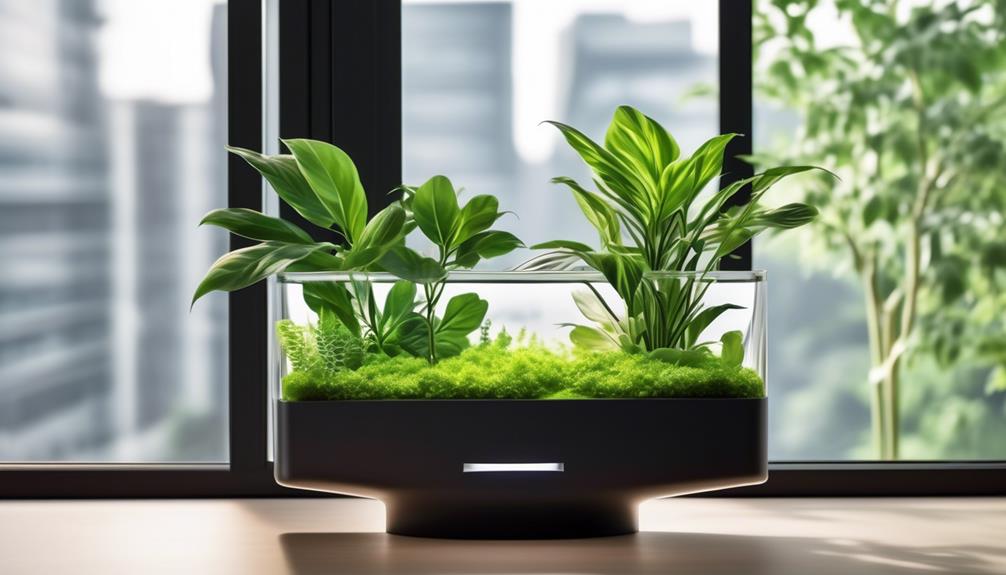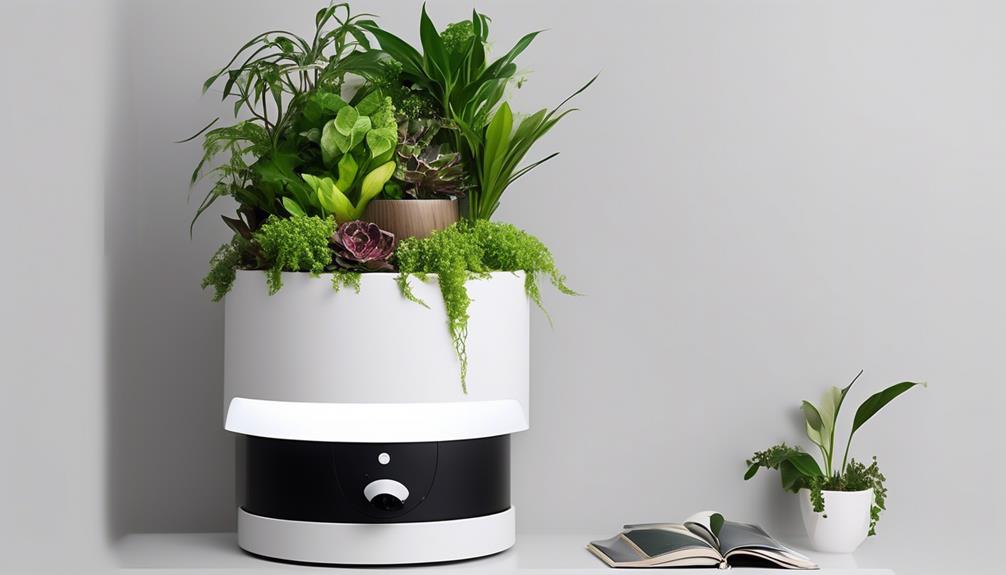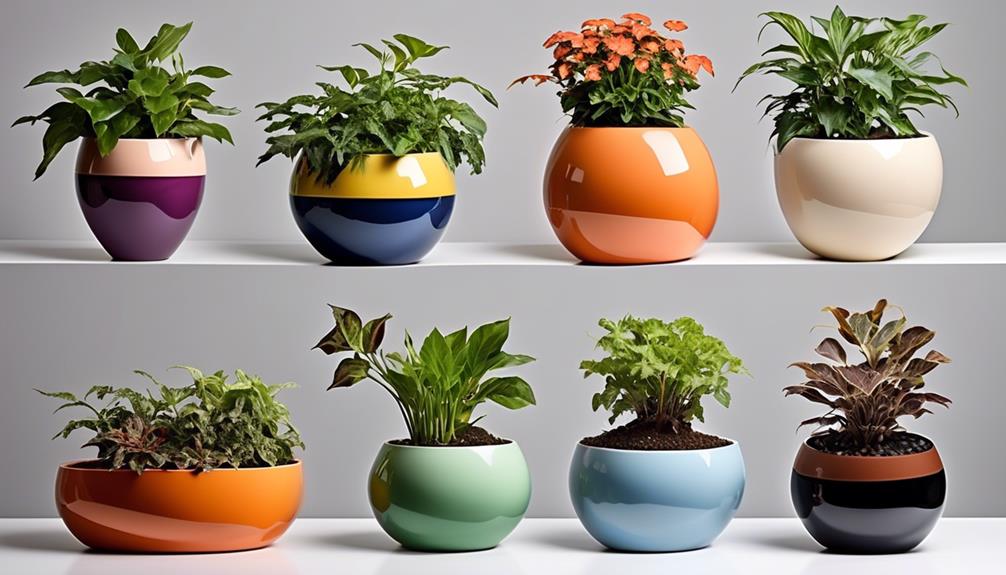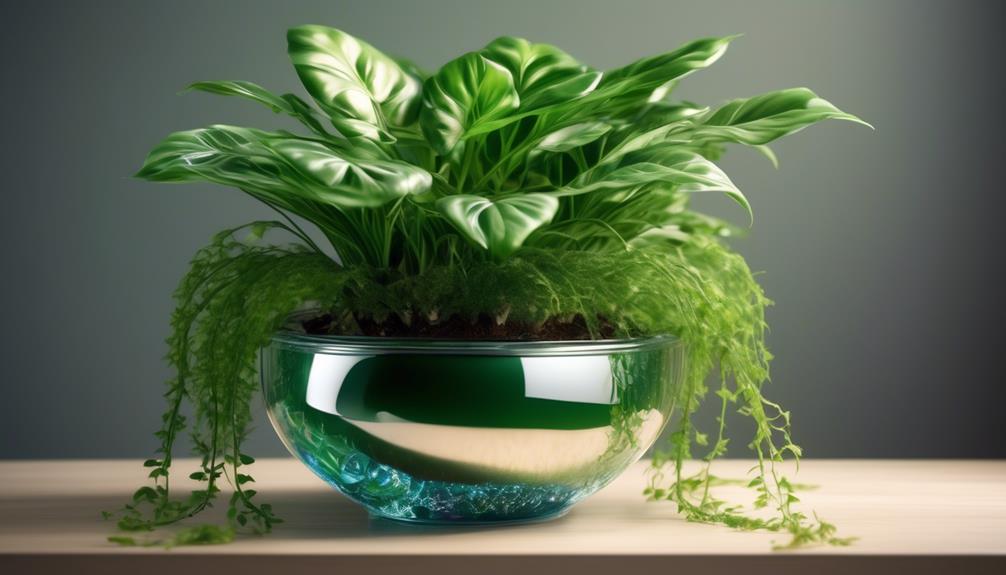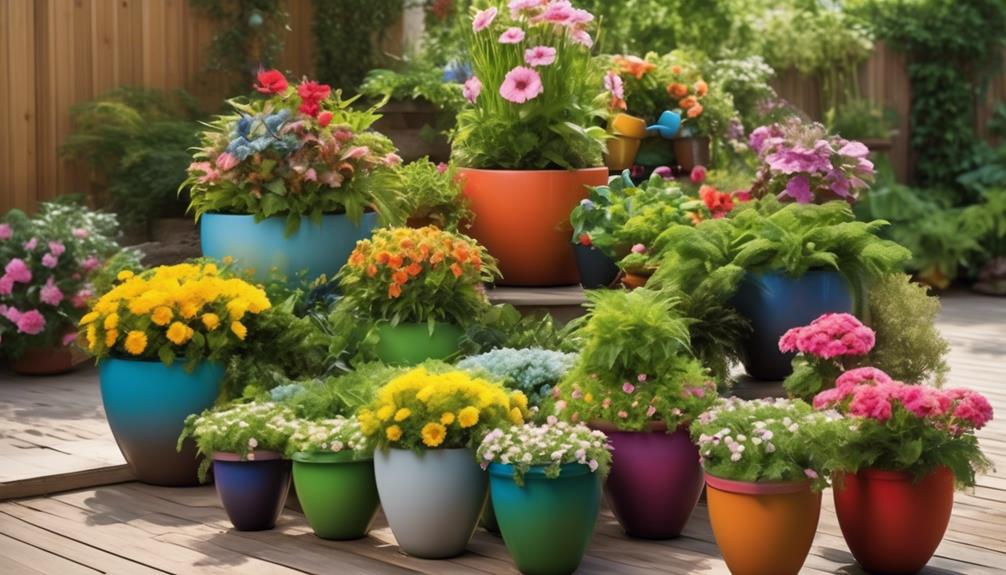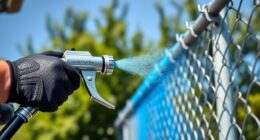Imagine entering a space filled with lush plants and vibrant flowers, all flourishing in their own self-watering pots, ensuring no water goes to waste or spills onto the ground.
The concept of self-watering indoor plant pots has revolutionized the way we nurture our houseplants, offering a convenient solution for busy individuals or those with a tendency to forget their watering duties.
But how do these pots actually work, and are they worth the investment?
Join us as we delve into the world of self-watering pots, exploring their benefits, functionality, and how to choose the perfect one for your beloved indoor plants.
Key Takeaways
- Self-watering pots provide a reliable and efficient method for maintaining optimal moisture levels in indoor plants.
- They help prevent overwatering or underwatering, promoting healthier root systems and overall plant growth.
- Self-watering pots contribute to water conservation by minimizing water wastage.
- They save time for individuals responsible for plant care.
Benefits of Self-Watering Pots
Self-watering pots provide a reliable and efficient method for maintaining optimal moisture levels in indoor plants. These pots have significant benefits for plant health and offer unparalleled convenience. By using self-watering pots, the risk of overwatering or underwatering is greatly reduced. The design of these pots ensures that plants receive the right amount of water, promoting healthier root systems and overall plant growth. This is especially beneficial for individuals who may not have a green thumb or those with busy lifestyles.
Moreover, self-watering pots contribute to water conservation by minimizing water wastage. The reservoir system allows for efficient use of water, ensuring that only the necessary amount is provided to the plant without any excess runoff. This not only benefits the environment but also saves time for the individuals responsible for plant care. With traditional pots, frequent watering and monitoring are essential, but self-watering pots alleviate these demands, making them a time-saving solution for plant enthusiasts.
How Self-Watering Pots Work
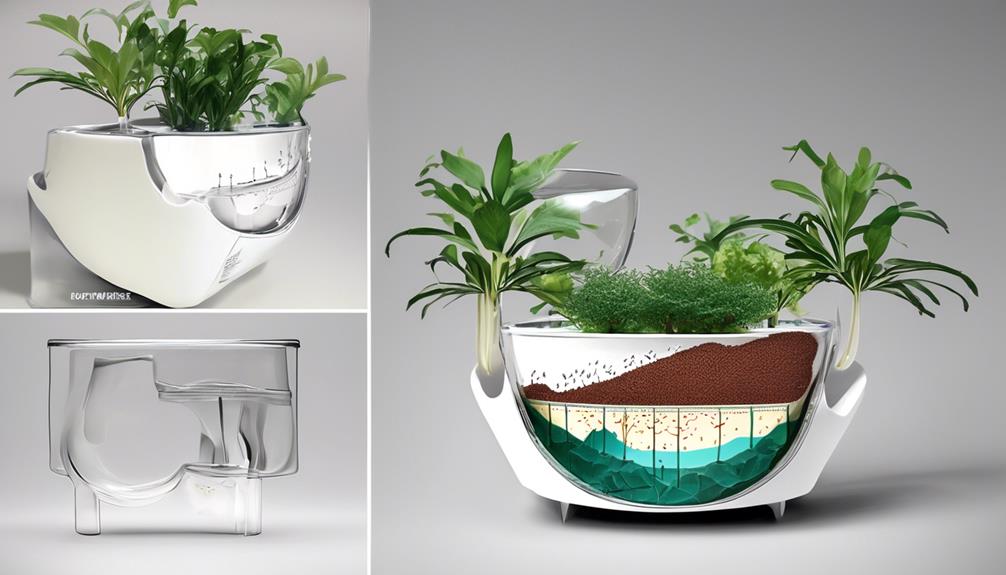
Utilizing a wicking system, self-watering pots draw water from a reservoir into the soil to maintain consistent moisture levels for indoor plants. This watering mechanism is based on the principle of capillary action, where water moves upwards through a porous material, such as soil, due to the forces of adhesion and cohesion.
The technology behind self-watering pots involves a water reservoir at the bottom, separated from the soil by a wick or a wicking mat. As the soil dries out, the wick draws water from the reservoir and delivers it to the roots of the plant, ensuring a steady supply of moisture.
The self-watering mechanism offers several plant health and growth benefits. By providing a consistent water supply, it prevents overwatering or underwatering, which are common issues with traditional pots. This helps in promoting healthier root development and overall plant growth. Additionally, the controlled moisture levels contribute to better nutrient uptake and can lead to lusher foliage and more vibrant blooms.
The technology behind self-watering pots serves as a reliable tool for ensuring the well-being of indoor plants, making it a valuable asset for plant enthusiasts and those who desire to serve the needs of their green companions.
Choosing the Right Self-Watering Pot
When selecting a self-watering pot, it's crucial to consider the specific needs and characteristics of the indoor plants that will be housed in them. To ensure the right choice, here are some key aspects to consider:
- Selecting Materials: Choose pots made from non-porous materials such as plastic or glazed ceramic to minimize evaporation and maintain consistent moisture levels for the plants.
- Size Considerations: Select pots that provide adequate space for the plant's root system to grow and thrive. The pot should be large enough to accommodate the plant without crowding, but not excessively large as it may lead to overwatering.
- Watering Mechanism: Assess the pot's watering mechanism and ensure it aligns with the specific watering needs of the plant species. Different plants have varying water requirements, and the pot's watering system should be adaptable to these needs.
- Aesthetic Appeal: While functionality is vital, also consider the visual appeal of the pot. Choose a design and color that complements the indoor space and enhances the overall aesthetic.
Maintaining Self-Watering Pots

To effectively maintain self-watering pots, it's essential to regularly monitor the water reservoir and adjust the watering frequency based on the plant's needs. Checking the water level in the reservoir should be done weekly, and if the water level is low, it should be refilled. However, if the water level remains consistently high, it might indicate overwatering, and adjustments to the watering schedule should be made.
It's important to ensure that the soil isn't waterlogged, as this can lead to root rot and other issues. Additionally, cleaning the water reservoir and the pot itself every month can prevent the buildup of algae, mold, or mineral deposits that may affect the plant's health.
Troubleshooting tips for self-watering pots include checking for any clogs in the watering system, ensuring that the wick is in good condition, and making sure that the soil isn't blocking the water flow.
When choosing plants for self-watering pots, it's important to select ones that thrive in consistently moist environments, such as peace lilies, spider plants, or pothos. These plants are well-suited to the self-watering system and are less likely to suffer from overwatering.
Top Recommendations for Self-Watering Pots
Regularly monitoring the water reservoir and adjusting the watering frequency based on the plant's needs is crucial for maintaining self-watering pots.
Here are our top recommendations for self-watering pots:
- Choose the Right Soil: Opt for a well-draining potting mix that allows water to move freely through the soil while retaining enough moisture for the plant's needs.
- Select the Appropriate Pot Size: Ensure the pot is the right size for your plant. A pot that's too small can lead to water overflow, while a pot that's too large may result in water stagnation.
- Place Pots in Adequate Light Conditions: Placing self-watering pots in areas with appropriate light levels for the specific plant species will help regulate water usage and prevent overwatering.
- Regularly Inspect the Pot and Water Levels: Check the pot and water reservoir regularly to ensure the system is functioning correctly. Adjust watering frequency as needed based on the plant's growth and environmental conditions.
When implementing these recommendations, plant care and the effectiveness of self-watering systems can be optimized, ensuring healthier and thriving indoor plants.
Frequently Asked Questions
Can Self-Watering Pots Be Used for All Types of Indoor Plants or Are There Certain Plants That Are Not Suitable for This Type of Pot?
Certain plants aren't suitable for self-watering pots. Factors such as root structure, water needs, and growth habits affect this. The best plants for self-watering pots are those with moderate water requirements and shallow root systems.
Ideal environments for self-watering pots are areas with consistent temperatures and humidity levels. Understanding the needs of your specific plant is crucial for successful growth in a self-watering pot.
Are There Any Potential Drawbacks or Disadvantages to Using Self-Watering Pots That I Should Be Aware Of?
Sure, potential drawbacks of self-watering pots include:
- The risk of overwatering, which can lead to root rot.
- The need for more maintenance due to the regular refilling of the water reservoir and occasional cleaning to prevent mold and algae growth.
However, with proper care and attention, these issues can be mitigated. This makes self-watering pots a convenient option for indoor plant care.
How Often Do I Need to Refill the Water Reservoir in a Self-Watering Pot, and Is There a Risk of Overwatering My Plants?
We typically need to refill the water reservoir in a self-watering pot every 1-2 weeks, based on the plant's water requirements and environmental conditions.
Overwatering can occur if the reservoir is constantly filled to the maximum level. However, the risk is mitigated by the self-regulating watering technology.
This method enhances plant growth by ensuring consistent moisture levels, reducing the risk of both over and under watering.
Can Self-Watering Pots Be Used for Outdoor Plants as Well, or Are They Specifically Designed for Indoor Use?
Sure, self-watering pots can be used for outdoor plants as well. There are benefits and drawbacks to consider.
It's essential to compare the performance of indoor and outdoor plants in self-watering pots. Factors like sunlight exposure, temperature variations, and plant types can affect how well the self-watering pots work outdoors.
Are There Any Specific Types of Soil or Potting Mix That Work Best With Self-Watering Pots, and Are There Any Special Considerations for Repotting Plants in These Pots?
When choosing the best potting mix for self-watering pots, it's essential to consider the water retention and aeration properties of the soil.
Additionally, when repotting plants in these pots, it's crucial to ensure that the new soil is compatible with the self-watering system.
We also need to be mindful of the watering frequency and any restrictions on outdoor use to maintain optimal plant health.
What are the Benefits of Using Self Watering Plant Pots Indoors?
Self watering plant pots are a game-changer for indoor gardening. By providing a consistent water supply, they eliminate the risk of over or under-watering. This not only saves time and effort but also promotes healthier plant growth. Additionally, they are perfect for those who travel frequently or have a busy schedule.
Conclusion
In conclusion, self-watering indoor plant pots offer a convenient and efficient solution for keeping your plants healthy and thriving. By choosing the right self-watering pot and maintaining it properly, you can ensure that your plants receive the right amount of water without the hassle of constant monitoring.
As the saying goes, 'A watched pot never boils,' so let your self-watering pot do the work for you and enjoy the benefits of beautiful, flourishing plants in your home.

